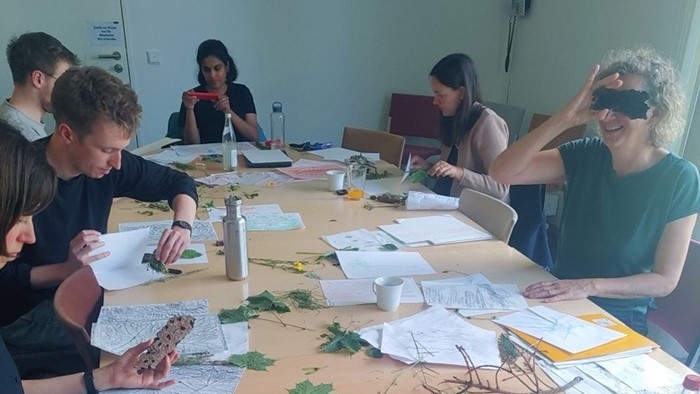Forest bathing and art in the Siebentischwald
The second artist workshop of the IDK “Rethinking Environment” started out in drizzly rain. Forest scientist, former forester and forestry official Wolfgang Sailer led the group through the Siebentischwald and explained the history of this forest and its immense importance for the health of the urban population. Since temperatures in the forest are 4 to 5 degrees Celsius below urban temperatures, it makes sense to bring contiguous forest vegetation into the city to combat the effects of global warming on all living things. At a junction, we followed photographer, environmental educator, and IDK PhD student Pia Wimmer along a narrow path between the trees, with our eyes closed. The concept known as “forest bathing” proved to be the perfect prelude to the creative activity that followed.
Artist Eva-Maria López distributed paper and colored wax to create so-called “frottages” - a creative technique used by surrealist Max Ernst, for example - to connect with the forest in an immediate, individual way. Pia also encouraged us to take photos with our mobile phones - an approach that relies heavily on cultural experiences and routines in dealing with photography and addresses the phenomenon of the “selfie.” This playful exercise stimulated deeper thinking about what it means to represent a forest, how “authentic” such representations are and how much we rely on our senses to create certain kinds of experiences.
Innovative approaches for urban climate protection
After an overview of her career as an artist with a long-standing focus on environmental issues (“Green Hour with Eva-Maria López”), we took the streetcar to Augsburg's Rathausplatz, where we were able to experience the artist's latest intervention: Eva-Maria's “paper-trees” app uses augmented reality to make a sustainable and climate-friendly future imaginable in the face of increasing climate impact problems. The amount of paper consumed by the population of Augsburg in a year is converted into trees in the app, creating shade, fresh air, and a climate-friendly and biodiverse public space.
Caspar Möller explained the aims of Miya Forest Eberswalde and presented examples of “tiny forests” in inner-city areas. It became clear how important the participation of the population is in the implementation of urban climate protection. During the concluding panel “Digital Humanities, Art and the Environment”, Caspar Möller, Eva-Maria López, Stefan Lindl and Pia Wimmer discussed how digital media can support the development of more sustainable, climate-friendly cities - but also the limitations of digitalization compared to other forms of environmental experience.
In the final workshop with Eva-Maria López, we creatively explored the forest and the things we had found there in the morning. It was the perfect setting to discuss how physical encounters with leaves, bark, small twigs etc. differ from photography and digital art.heavily on cultural experiences and routines in dealing with photography and addresses the phenomenon of the “selfie.” This playful exercise stimulated deeper thinking about what it means to represent a forest, how “authentic” such representations are and how much we rely on our senses to create certain kinds of experiences.
Text: PD. Dr. Kirsten Twelbeck and Laura Grötsch, International Doctoral Program “Rethinking Environment”


